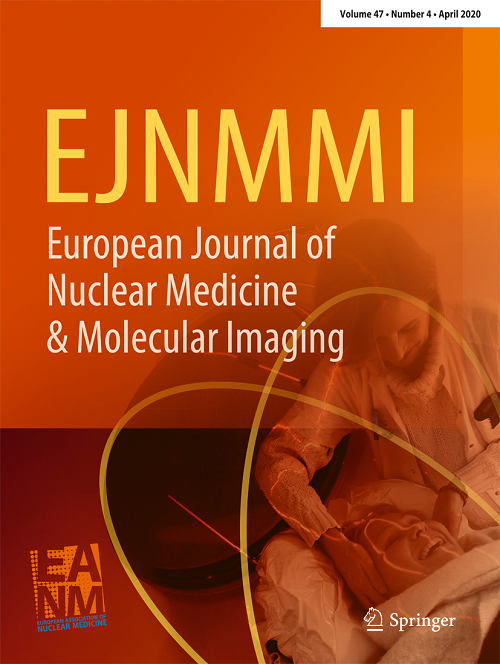The role of [⁶⁸Ga]Ga-FAP-2286 PET/CT in the evaluation of treatment response in gastrointestinal system malignancies.
IF 7.6
1区 医学
Q1 RADIOLOGY, NUCLEAR MEDICINE & MEDICAL IMAGING
European Journal of Nuclear Medicine and Molecular Imaging
Pub Date : 2025-09-30
DOI:10.1007/s00259-025-07597-1
引用次数: 0
Abstract
OBJECTIVE This study aimed to investigate the potential efficacy of [⁶⁸Ga]Ga-FAP-2286 PET/CT in evaluating treatment response in patients with gastrointestinal system malignancies. MATERIALS AND METHODS Patients with histopathologically confirmed gastrointestinal malignancies who underwent [⁶⁸Ga]Ga-FAP-2286 PET/CT for treatment response assessment between November 2020 and January 2025 were included. All images were evaluated by three experienced nuclear medicine physicians. The maximum standardized uptake values (SUVmax), total tumor volumes, and total lesion FAP expression values of primary tumors and metastases were recorded. At the same time, serum tumor marker levels were analyzed. Imaging responses were assessed separately according to PERCIST criteria on [⁶⁸Ga]Ga-FAP-2286 PET/CT and RECIST criteria on CT. Survival outcomes were analyzed using the Kaplan-Meier method, and their association with treatment response on [⁶⁸Ga]Ga-FAP-2286 PET/CT was assessed using the Log-Rank (Mantel-Cox) test and Cox proportional hazards regression. A p-value < 0.05 was considered statistically significant in all analyses. RESULTS A total of 100 [⁶⁸Ga]Ga-FAP-2286 PET/CT scans were performed in 50 patients (mean age: 61.62 ± 12.95), both before and after treatment. Among the included patients, 70% had gastric cancer, 14% had colon cancer, 8% had pancreatic cancer, 4% had appendiceal cancer, 2% had hepatocellular carcinoma (HCC), and 2% had cholangiocellular carcinoma. Primary/recurrent tumor lesions were observed in 62% of patients, lymph node metastases in 24%, visceral metastases in 10%, peritoneal metastases in 76%, and bone metastases in 14%. A strong correlation was found between tumor volumes and total lesion FAP expression measured by [⁶⁸Ga]Ga-FAP-2286 PET/CT and the corresponding serum tumor markers (Area Under the Curve [AUC] for delta tumor volume and total lesion FAP expression = 0.875). There was a statistically significant and near-perfect concordance between [⁶⁸Ga]Ga-FAP-2286 PET PERCIST and CT RECIST criteria (Kappa = 0.833, p < 0.05). Moderate agreement was found for primary tumors (Kappa = 0.526, p < 0.05) and bone metastases (Kappa = 0.657, p < 0.05), while excellent agreement was observed for lymph node (Kappa = 1.0, p < 0.05), peritoneal (Kappa = 0.815, p < 0.05), and visceral metastases (Kappa = 1.0, p < 0.05). According to the Kaplan-Meier analysis, treatment response assessed by [⁶⁸Ga]Ga-FAP-2286 PET/CT was predictive of overall survival (p = 0.02). Median overall survival was 7.6 months in patients with progressive disease and 19.8 months in those with stable disease, as defined by PERCIST criteria. Median survival was not reached in patients showing partial or complete response. CONCLUSION In gastrointestinal system malignancies, a strong correlation was observed between serum tumor markers and both total tumor volumes and total lesion FAP expression values derived from [⁶⁸Ga]Ga-FAP-2286 PET imaging. Additionally, molecular response assessed by [⁶⁸Ga]Ga-FAP-2286 PET/CT was predictive of overall survival. [⁶⁸Ga]Ga-FAP-2286 PET/CT appears to be an effective tool for assessing treatment response and monitoring patients with gastrointestinal malignancies.[26⁸Ga]Ga- fap -2286 PET/CT在胃肠系统恶性肿瘤治疗反应评价中的作用
目的探讨[⁶⁸Ga]Ga- fap -2286 PET/CT在胃肠道系统恶性肿瘤患者治疗反应评价中的潜在疗效。材料与方法纳入2020年11月至2025年1月期间接受[⁶⁸Ga]Ga- fap -2286 PET/CT治疗反应评估的经组织病理学证实的胃肠道恶性肿瘤患者。所有图像均由三名经验丰富的核医学医师评估。记录原发肿瘤和转移瘤的最大标准化摄取值(SUVmax)、肿瘤总体积、病灶总FAP表达值。同时分析血清肿瘤标志物水平。分别根据[⁶⁸Ga]Ga- fap -2286 PET/CT上的PERCIST标准和CT上的RECIST标准评估成像反应。采用Kaplan-Meier法分析患者的生存结局,并采用Log-Rank (Mantel-Cox)检验和Cox比例风险回归评估其与[⁶⁸Ga]Ga- fap -2286 PET/CT治疗反应的相关性。p值< 0.05被认为在所有分析中具有统计学意义。结果50例患者(平均年龄:61.62±12.95)在治疗前后均进行了PET/CT扫描,共进行了100[⁶⁸Ga]Ga- fap -2286 PET/CT扫描。在纳入的患者中,70%为胃癌,14%为结肠癌,8%为胰腺癌,4%为阑尾癌,2%为肝细胞癌,2%为胆管细胞癌。62%的患者有原发性/复发性肿瘤病变,24%的患者有淋巴结转移,10%的患者有内脏转移,76%的患者有腹膜转移,14%的患者有骨转移。用[⁶⁸Ga]Ga-FAP-2286 PET/CT测定的肿瘤体积和病变总FAP表达与相应的血清肿瘤标志物之间存在较强的相关性(δ肿瘤体积和病变总FAP表达的曲线下面积[AUC] = 0.875)。[⁶⁸Ga]Ga- fap -2286 PET PERCIST与CT RECIST指标的一致性有统计学意义(Kappa = 0.833, p < 0.05)。原发性肿瘤(Kappa = 0.526, p < 0.05)和骨转移(Kappa = 0.657, p < 0.05)的一致性中等,而淋巴结(Kappa = 1.0, p < 0.05)、腹膜(Kappa = 0.815, p < 0.05)和内脏转移(Kappa = 1.0, p < 0.05)的一致性极好。根据Kaplan-Meier分析,[⁶⁸Ga]Ga- fap -2286 PET/CT评估的治疗反应可预测总生存期(p = 0.02)。根据PERCIST标准,疾病进展患者的中位总生存期为7.6个月,疾病稳定患者的中位总生存期为19.8个月。显示部分或完全缓解的患者中位生存期未达到。结论在胃肠道恶性肿瘤中,血清肿瘤标志物与[⁶⁸Ga]Ga-FAP-2286 PET显像得出的肿瘤总体积和病变总FAP表达值有很强的相关性。此外,通过[⁶⁸Ga]Ga- fap -2286 PET/CT评估的分子反应可预测总生存期。[26⁸Ga]Ga- fap -2286 PET/CT似乎是评估胃肠道恶性肿瘤患者治疗反应和监测的有效工具。
本文章由计算机程序翻译,如有差异,请以英文原文为准。
求助全文
约1分钟内获得全文
求助全文
来源期刊
CiteScore
15.60
自引率
9.90%
发文量
392
审稿时长
3 months
期刊介绍:
The European Journal of Nuclear Medicine and Molecular Imaging serves as a platform for the exchange of clinical and scientific information within nuclear medicine and related professions. It welcomes international submissions from professionals involved in the functional, metabolic, and molecular investigation of diseases. The journal's coverage spans physics, dosimetry, radiation biology, radiochemistry, and pharmacy, providing high-quality peer review by experts in the field. Known for highly cited and downloaded articles, it ensures global visibility for research work and is part of the EJNMMI journal family.

 求助内容:
求助内容: 应助结果提醒方式:
应助结果提醒方式:


